How the Updated Earth System Models Project Terrestrial Gross Primary Productivity in China under 1.5 and 2 °C Global Warming
Abstract
:1. Introduction
2. Materials and Methods
2.1. Data
2.2. Methods
2.2.1. Bilinear Interpolation
2.2.2. Area Weighting
2.2.3. Linear Correlation and Multiple Regression
3. Results and Discussion
3.1. GPP Distribution and Projected Changes
3.2. Climate Attribution
4. Conclusions
- Under 1.5 and 2 °C of global warming, the projections of the ESMs indicate that global warming introduces no ecological risk in China. Although certain individual grid points showed negative GPP changes, regional GPP showed a marked increase, the smallest magnitude of which was more than 10% greater than that from 1986 to 2005.
- Specifically under 1.5 °C warming, the GPP in the temperate continental zone is projected to increase by 16.1–23.8% in comparison with the historical value (1986–2005). Similarly, GPP is projected to increase by 12.3–16.1% in the temperate monsoonal zone, 12.5–14.7% in the subtropical–tropical monsoonal zone, and 20.0–37.0% on the Tibetan Plateau. Under 2 °C warming, the increase in GPP is projected to be even greater—i.e., 23.0–34.3% in the temperate continental zone, 21.2–24.4% in the temperate monsoonal zone, 16.1–28.4% in the subtropical–tropical monsoonal zone, and 28.4–63.0% on the Tibetan Plateau.
- Climate change is projected to contribute positively to GPP change, except in the temperate continental zone with MPI-ESM1-2-HR. Although precipitation has larger sensitivity parameters, temperature generally plays a more important role in GPP change because of the larger change relative to its own variability in comparison with that of precipitation.
Author Contributions
Funding
Acknowledgments
Conflicts of Interest
References
- Beer, C.; Reichstein, M.; Tomelleri, E.; Ciais, P.; Jung, M.; Carvalhais, N.; Rödenbeck, C.; Arain, M.A.; Baldocchi, D.; Bonan, G.B.; et al. Terrestrial gross carbon dioxide uptake: Global distribution and covariation with climate. Science 2010, 329, 834–838. [Google Scholar] [CrossRef] [PubMed] [Green Version]
- Schimel, D.S.; House, J.I.; Hibbard, K.A.; Bousquet, P.; Ciais, P.; Peylin, P.; Braswell, B.H.; Apps, M.J.; Baker, D.; Bondeau, A.; et al. Recent patterns and mechanisms of carbon exchange by terrestrial ecosystems. Nature 2001, 414, 169–172. [Google Scholar] [CrossRef]
- Zhang, C.; Wu, S.; Leng, G. Possible NPP changes and risky ecosystem region identification in China during the 21st century based on BCC-CSM2. J. Geogr. Sci. 2020, 30, 1219–1232. [Google Scholar] [CrossRef]
- Huang, Q.; Ju, W.; Zhang, F.; Zhang, Q. Roles of climate change and increasing CO2 in driving changes of net primary productivity in China simulated using a dynamic global vegetation model. Sustainability 2019, 11, 4176. [Google Scholar] [CrossRef] [Green Version]
- Schlund, M.; Eyring, V.; Camps-Valls, G.; Friedlingstein, P.; Gentine, P.; Reichstein, M. Constraining uncertainty in projected gross primary production with machine learning. J. Geophys. Res. Biogeosci. 2020, 125, e2019JG005619. [Google Scholar] [CrossRef]
- Van Vuuren, D.P.; Edmonds, J.; Kainuma, M.; Riahi, K.; Thomson, A.; Hibbard, K.; Hurtt, G.C.; Kram, T.; Krey, V.; Lamarque, J.F.; et al. The representative concentration pathways: An overview. Clim. Chang. 2011, 109, 5–31. [Google Scholar] [CrossRef]
- Yue, X.; Liao, H.; Wang, H.; Zhang, T.; Unger, N.; Sitch, S.; Feng, Z.; Yang, J. Pathway dependence of ecosystem responses in China to 1.5 °C global warming. Atmos. Chem. Phys. 2020, 20, 2353–2366. [Google Scholar] [CrossRef] [Green Version]
- Riahi, K.; Van Vuuren, D.P.; Kriegler, E.; Edmonds, J.; O’neill, B.C.; Fujimori, S.; Bauer, N.; Calvin, K.; Dellink, R.; Fricko, O.; et al. The shared socioeconomic pathways and their energy, land use, and greenhouse gas emissions implications: An overview. Glob. Environ. Chang. 2017, 42, 153–168. [Google Scholar] [CrossRef] [Green Version]
- Wang, T.; Lin, X.; Liu, Y.; Dantec-Nédélec, S.; Ottle, C. Causes of uncertainty in China’s net primary production over the 21st century projected by the CMIP5 Earth system models. Int. J. Climatol. 2016, 36, 2323–2334. [Google Scholar] [CrossRef] [Green Version]
- Zhang, C.; Deng, Y. How the CMIP6 models project the historical terrestrial GPP in China. Ecosystem 2021. in review. [Google Scholar]
- Wu, T.; Lu, Y.; Fang, Y.; Xin, X.; Li, L.; Li, W.; Jie, W.; Zhang, J.; Liu, Y.; Zhang, L.; et al. The Beijing Climate Center Climate System Model (BCC-CSM): The main progress from CMIP5 to CMIP6. Geosci. Model Dev. 2019, 12, 1573–1600. [Google Scholar] [CrossRef] [Green Version]
- Cherchi, A.; Fogli, P.G.; Lovato, T.; Peano, D.; Iovino, D.; Gualdi, S.; Masina, S.; Scoccimarro, E.; Materia, S.; Bellucci, A.; et al. Global mean climate and main patterns of variability in the CMCC-CM2 coupled model. J. Adv. Modeling Earth Syst. 2019, 11, 185–209. [Google Scholar] [CrossRef] [Green Version]
- Mauritsen, T.; Bader, J.; Becker, T.; Behrens, J.; Bittner, M.; Brokopf, R.; Brovkin, V.; Claussen, M.; Crueger, T.; Esch, M.; et al. Developments in the MPI-M Earth System Model version 1.2 (MPI-ESM1.2) and Its Response to Increasing CO2. J. Adv. Modeling Earth Syst. 2019, 11, 998–1038. [Google Scholar] [CrossRef] [Green Version]
- Li, W.; Zhang, Y.; Shi, X.; Zhou, W.; Huang, A.; Mu, M.; Qiu, B.; Ji, J. Development of land surface model BCC_AVIM2.0 and its preliminary performance in LS3MIP/CMIP6. J. Meteorol. Res. 2019, 33, 851–869. [Google Scholar] [CrossRef]
- He, H.; Wang, S.; Zhang, L.; Wang, J.; Ren, X.; Zhou, L.; Piao, S.; Yan, H.; Ju, W.; Gu, F.; et al. Altered trends in carbon uptake in China’s terrestrial ecosystems under the enhanced summer monsoon and warming hiatus. Natl. Sci. Rev. 2019, 6, 505–514. [Google Scholar] [CrossRef] [Green Version]
- Zhang, L.; Ren, X.; Wang, J.; He, H.; Wang, S.; Wang, M.; Piao, S.; Yan, H.; Ju, W.; Gu, F.; et al. Interannual variability of terrestrial net ecosystem productivity over China: Regional contributions and climate attribution. Environ. Res. Lett. 2019, 14, 014003. [Google Scholar] [CrossRef]
- Bovik, A.C. The Essential Guide to Image Processing; Academic Press: Cambridge, MA, USA, 2009. [Google Scholar]
- Peng, S.; Piao, S.; Ciais, P.; Myneni, R.B.; Chen, A.; Chevallier, F.; Dolman, A.J.; Janssens, I.A.; Penuelas, J.; Zhang, G.; et al. Asymmetric effects of daytime and night-time warming on Northern Hemisphere vegetation. Nature 2013, 501, 88–92. [Google Scholar] [CrossRef]
- Yao, Y.; Wang, X.; Li, Y.; Wang, T.; Shen, M.; Du, M.; He, H.; Li, Y.; Luo, W.; Ma, M.; et al. Spatiotemporal pattern of gross primary productivity and its covariation with climate in China over the last thirty years. Glob. Chang. Biol. 2018, 24, 184–196. [Google Scholar] [CrossRef] [PubMed]
- Piao, S.; Sitch, S.; Ciais, P.; Friedlingstein, P.; Peylin, P.; Wang, X.; Ahlström, A.; Anav, A.; Canadell, J.G.; Cong, N.; et al. Evaluation of terrestrial carbon cycle models for their response to climate variability and to CO2 trends. Glob. Chang. Biol. 2013, 19, 2117–2132. [Google Scholar] [CrossRef] [Green Version]
- Zhou, L.; Dickinson, R.E.; Tian, Y.; Vose, R.S.; Dai, Y. Impact of vegetation removal and soil aridation on diurnal temperature range in a semiarid region: Application to the Sahel. Proc. Natl. Acad. Sci. USA 2007, 104, 17937–17942. [Google Scholar] [CrossRef] [Green Version]
- Zhou, C.; Wang, K.; Ma, Q. Evaluation of eight current reanalyses in simulating land surface temperature from 1979 to 2003 in China. J. Clim. 2017, 30, 7379–7398. [Google Scholar] [CrossRef]
- Podobnik, B.; Stanley, H.E. Detrended cross-correlation analysis: A new method for analyzing two nonstationary time series. Phys. Rev. Lett. 2008, 100, 084102. [Google Scholar] [CrossRef] [PubMed] [Green Version]
- IPCC. Climate Change 2013: The Physical Science Basis; Cambridge University Press: Cambridge, UK, 2013. [Google Scholar]
- Zhai, P.; Yu, R.; Zhou, B.; Chen, Y.; Guo, J.; Lu, Y. Research progress in impact of 1.5 °C global warming on global and regional scales. Clim. Chang. Res. 2017, 13, 465–472. (In Chinese) [Google Scholar]
- Rojas, M.; Lambert, F.; Ramirez-Villegas, J.; Challinor, A.J. Emergence of robust precipitation changes across crop production areas in the 21st century. Proc. Natl. Acad. Sci. USA 2019, 116, 6673–6678. [Google Scholar] [CrossRef] [Green Version]
- Knutti, R.; Sedláček, J. Robustness and uncertainties in the new CMIP5 climate model projections. Nat. Clim. Chang. 2013, 3, 369–373. [Google Scholar] [CrossRef]
- Kusunoki, S.; Arakawa, O. Are CMIP5 models better than CMIP3 models in simulating precipitation over East Asia? J. Clim. 2015, 28, 5601–5621. [Google Scholar] [CrossRef]
- Mu, Q.; Zhao, M.; Running, S.W.; Liu, M.; Tian, H. Contribution of increasing CO2 and climate change to the carbon cycle in China’s ecosystems. J. Geophys. Res. Biogeosci. 2008, 113, G01018. [Google Scholar] [CrossRef] [Green Version]
- Ma, X.; Huo, T.; Zhao, C.; Yan, W.; Zhang, X. Projection of Net Primary Productivity under Global Warming Scenarios of 1.5 °C and 2.0 °C in Northern China Sandy Areas. Atmosphere 2020, 11, 71. [Google Scholar] [CrossRef] [Green Version]
- Jung, M.; Schwalm, C.; Migliavacca, M.; Walther, S.; Camps-Valls, G.; Koirala, S.; Anthoni, P.; Besnard, S.; Bodesheim, P.; Carvalhais, N.; et al. Scaling carbon fluxes from eddy covariance sites to globe: Synthesis and evaluation of the FLUXCOM approach. Biogeosciences 2020, 17, 1343–1365. [Google Scholar] [CrossRef] [Green Version]
- Tong, K.; Su, F.; Yang, D.; Zhang, L.; Hao, Z. Tibetan Plateau precipitation as depicted by gauge observations, reanalyses and satellite retrievals. Int. J. Climatol. 2014, 34, 265–285. [Google Scholar] [CrossRef]
- Zhang, C. Moisture source assessment and the varying characteristics for the Tibetan Plateau precipitation using TRMM. Environ. Res. Lett. 2020, 15, 104003. [Google Scholar] [CrossRef]
- Pan, C.; Zhu, B.; Gao, J.; Kang, H.; Zhu, T. Quantitative identification of moisture sources over the Tibetan Plateau and the relationship between thermal forcing and moisture transport. Clim. Dyn. 2019, 52, 181–196. [Google Scholar] [CrossRef]
- Sage, R.F.; Wedin, D.A.; Li, M. The Biogeography of C4 Photosyn-Thesis: Patterns and Controlling Factors; Sage, R.F., Monsoon, R.K., Eds.; C4 Plant Biology; Academic Press: San Diego, CA, USA, 1999; pp. 313–373. [Google Scholar]
- Sitch, S.; Smith, B.; Prentice, I.C.; Arneth, A.; Bondeau, A.; Cramer, W.; Kaplan, J.O.; Levis, S.; Lucht, W.; Sykes, M.T.; et al. Evaluation of ecosystem dynamics, plant geography and terrestrial carbon cycling in the LPJ dynamic global vegetation model. Glob. Chang. Biol. 2003, 9, 161–185. [Google Scholar] [CrossRef]
- Wand, S.J.; Midgley, G.F.; Jones, M.H.; Curtis, P.S. Responses of wild C4 and C3 grass (Poaceae) species to elevated atmospheric CO2 concentration: A meta-analytic test of current theories and perceptions. Glob. Chang. Biol. 1999, 5, 723–741. [Google Scholar] [CrossRef] [Green Version]
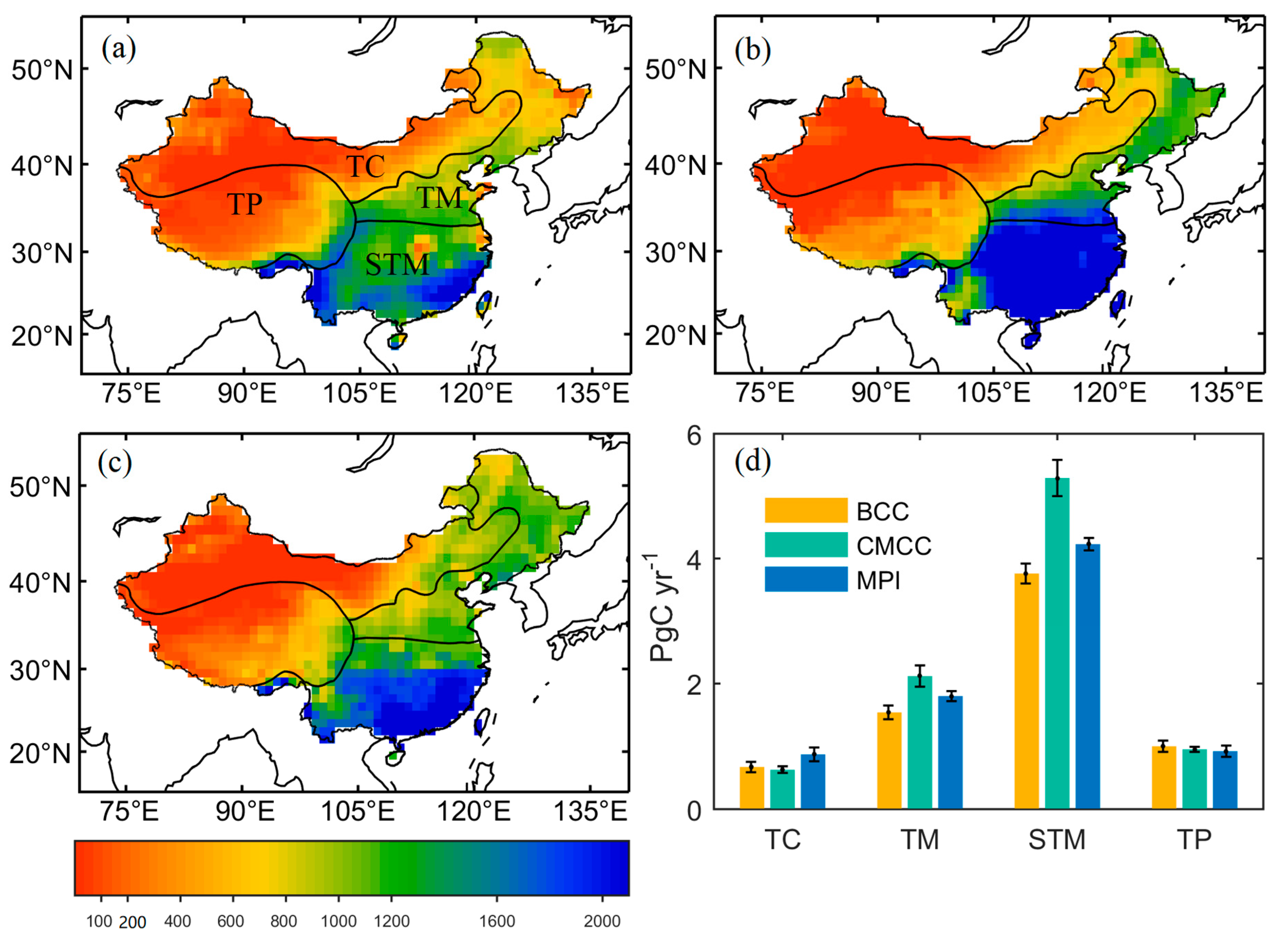
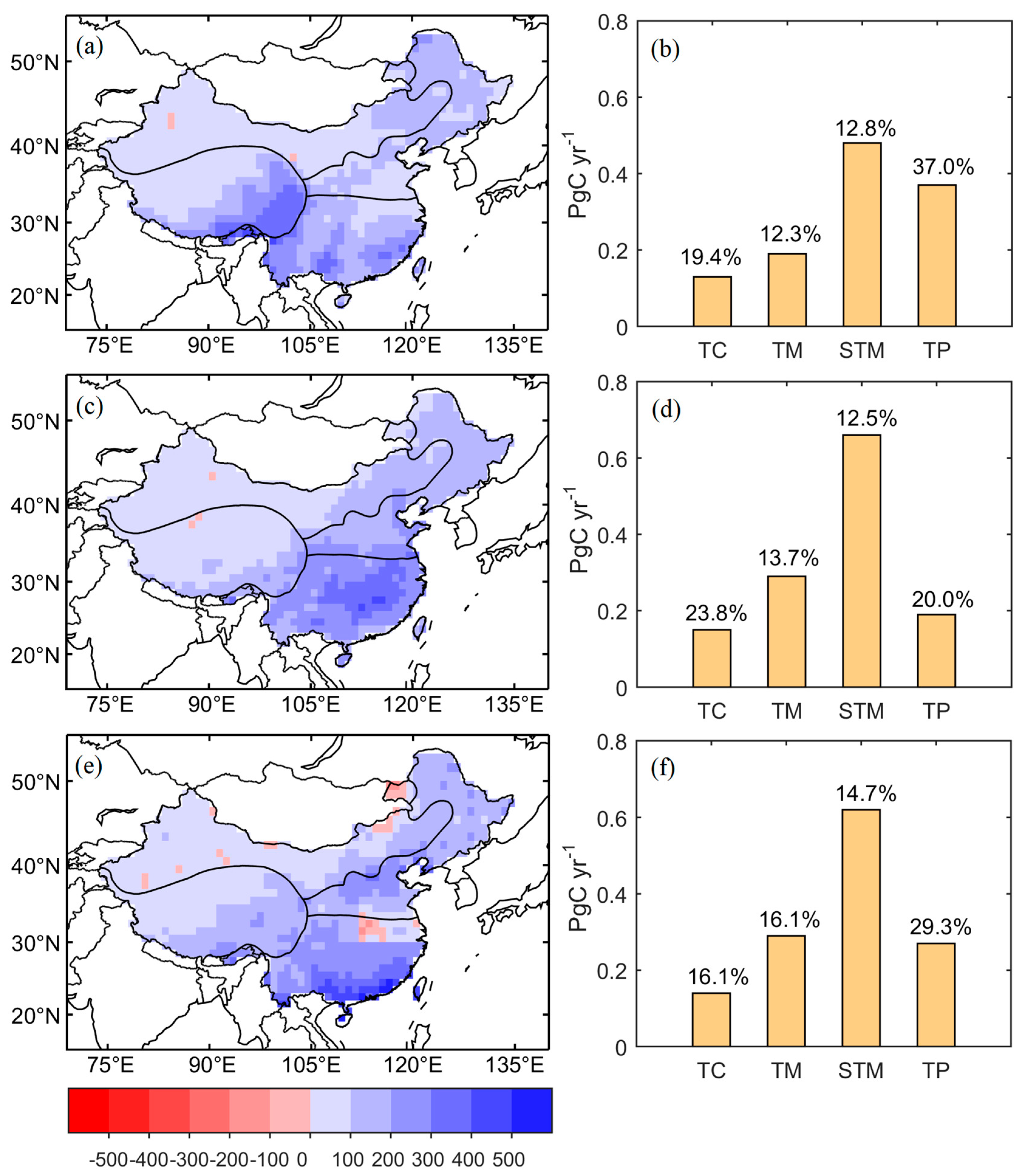
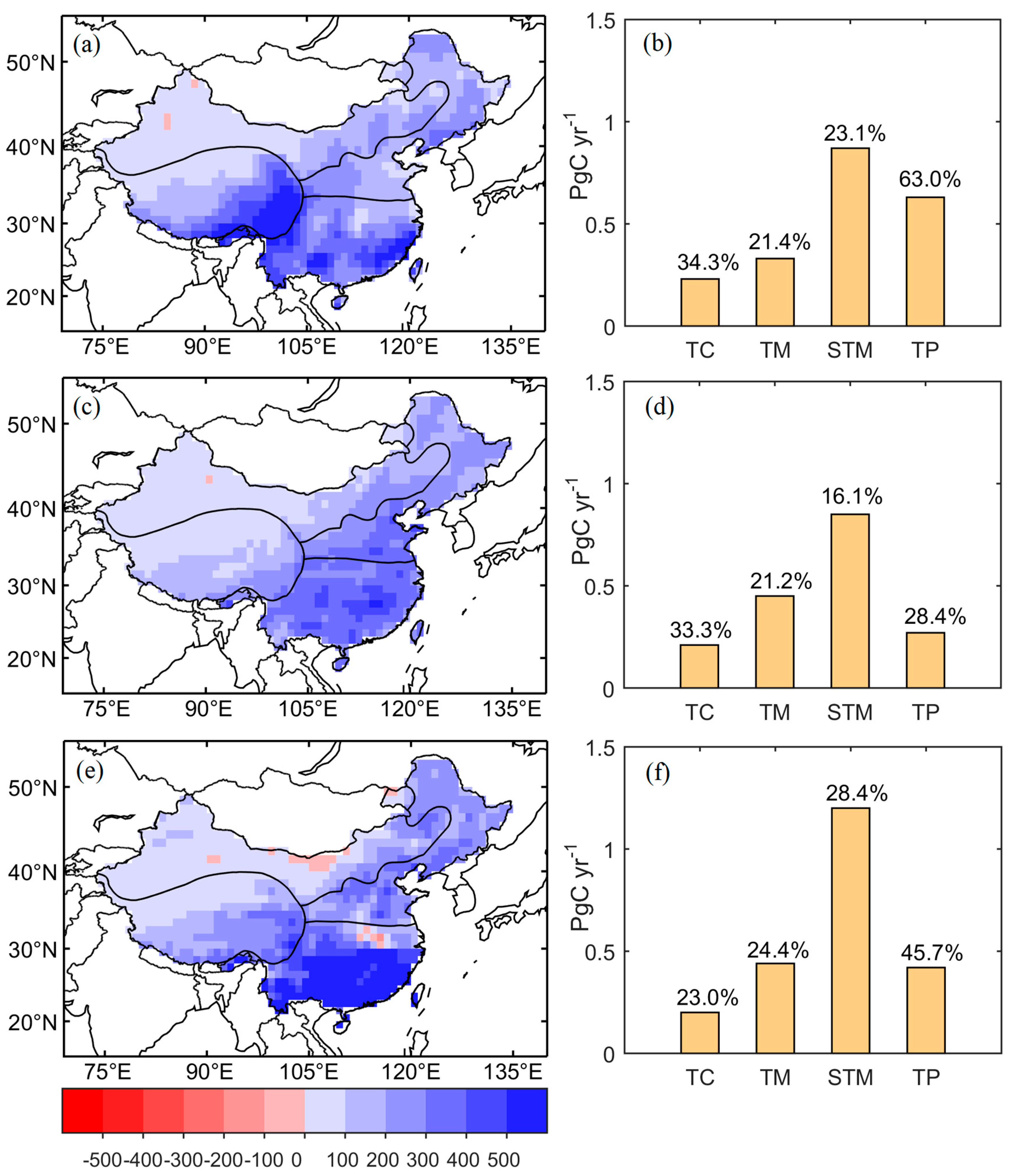
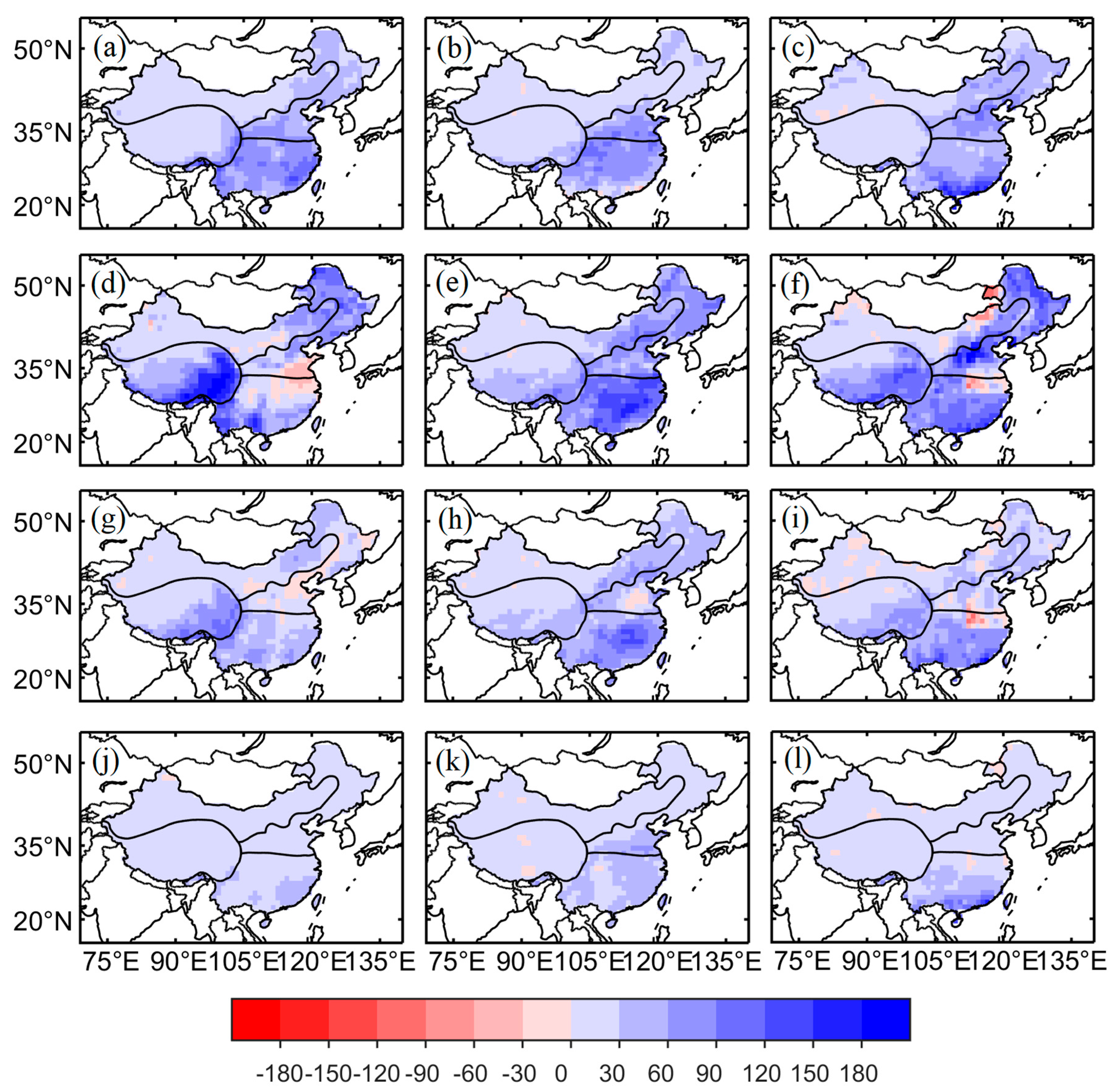

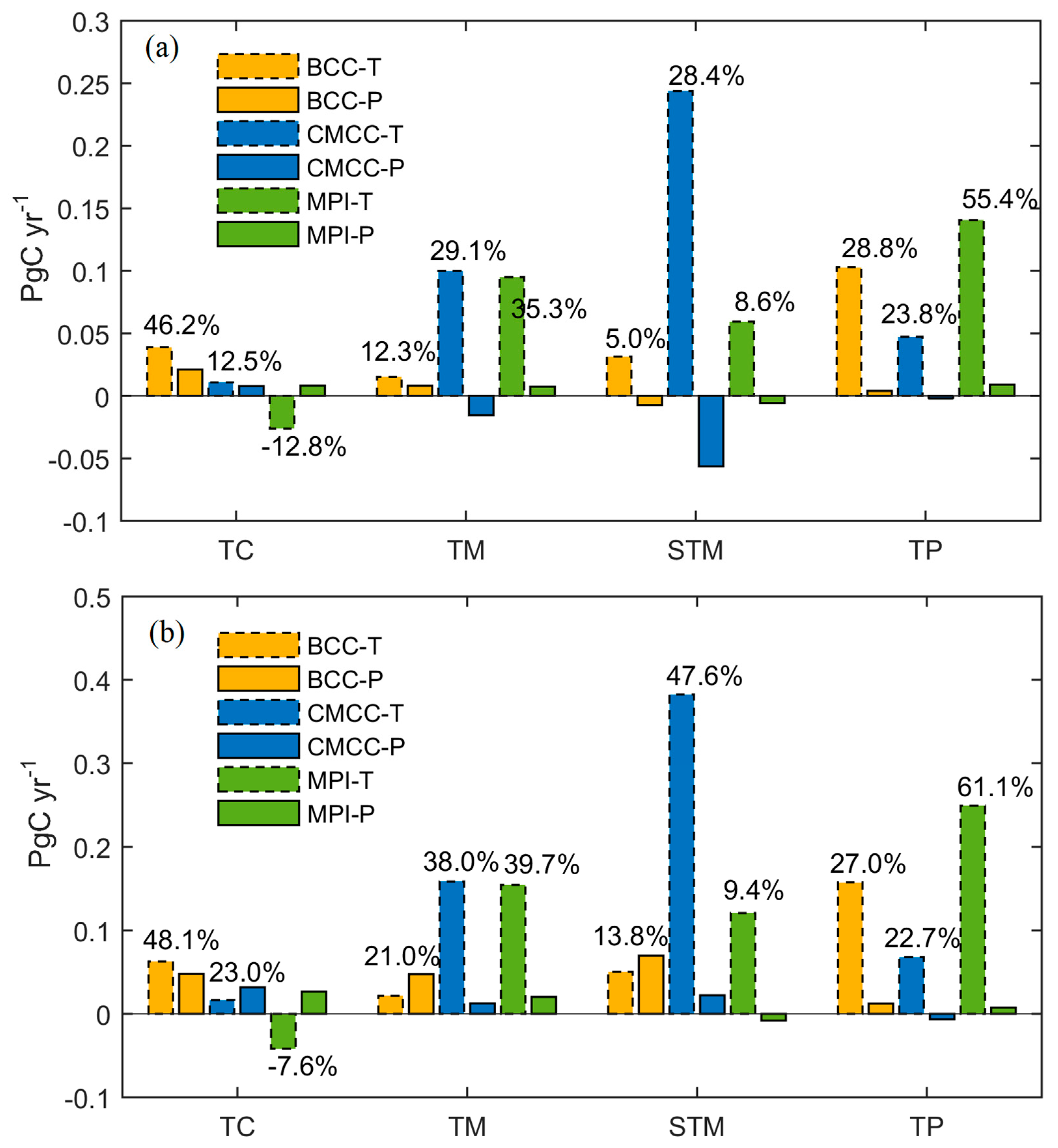
| GPP vs. P | TC | TM | STM | TP |
|---|---|---|---|---|
| BCC | 0.68 *** | 0.74 *** | 0.62 *** | 0.1 |
| CMCC | 0.72 *** | 0.58 *** | 0.42 ** | −0.01 |
| MPI | 0.81 *** | 0.36 ** | −0.26 | 0.23 |
| GPP vs. T | ||||
| BCC | −0.09 | −0.35 ** | −0.25 | 0.35 ** |
| CMCC | 0.17 | 0.42 ** | 0.34 * | 0.74 *** |
| MPI | −0.42 ** | 0.13 | 0.33 * | 0.62 *** |
| TC | TM | STM | TP | |
|---|---|---|---|---|
| BCC | 1.37(2.21) | 1.66(2.37) | 1.16(1.86) | 1.37(2.10) |
| CMCC | 1.28(1.94) | 1.12(1.78) | 0.81(1.27) | 1.19(1.71) |
| MPI | 1.18(1.89) | 1.1(1.79) | 0.83(1.69) | 1.14(2.02) |
| TC | TM | STM | TP | |
|---|---|---|---|---|
| BCC | 12.47(28.22) | 8.11(47.13) | −6.18(57.36) | 10.37(32.23) |
| CMCC | 11.31(45.68) | −20.08(16.22) | −51.89(20.50) | 30.24(94.89) |
| MPI | 2.65(8.66) | 6.91(19.23) | 32.83(46.13) | 11.5(9.42) |
| Temperate Continental | BCC | CMCC | MPI |
|---|---|---|---|
| P | 0.8 | 0.72 | 0.77 |
| T | 0.26 | 0.14 | −0.1 |
| Var | 52.20% | 54.00% | 66.50% |
| Temperate monsoonal | |||
| P | 0.78 | 0.54 | 0.66 |
| T | 0.06 | 0.35 | 0.52 |
| Var | 55.40% | 45.90% | 30.20% |
| Subtropical–tropical monsoonal | |||
| P | 0.64 | 0.51 | −0.15 |
| T | 0.06 | 0.44 | 0.28 |
| Var | 38.10% | 36.30% | 13.10% |
| Tibetan Plateau | |||
| P | 0.16 | −0.1 | 0.46 |
| T | 0.38 | 0.75 | 0.75 |
| Var | 15.00% | 55.70% | 57.50% |
Publisher’s Note: MDPI stays neutral with regard to jurisdictional claims in published maps and institutional affiliations. |
© 2021 by the authors. Licensee MDPI, Basel, Switzerland. This article is an open access article distributed under the terms and conditions of the Creative Commons Attribution (CC BY) license (https://creativecommons.org/licenses/by/4.0/).
Share and Cite
Zhang, C.; Wu, S.; Deng, Y.; Chou, J. How the Updated Earth System Models Project Terrestrial Gross Primary Productivity in China under 1.5 and 2 °C Global Warming. Sustainability 2021, 13, 11744. https://doi.org/10.3390/su132111744
Zhang C, Wu S, Deng Y, Chou J. How the Updated Earth System Models Project Terrestrial Gross Primary Productivity in China under 1.5 and 2 °C Global Warming. Sustainability. 2021; 13(21):11744. https://doi.org/10.3390/su132111744
Chicago/Turabian StyleZhang, Chi, Shaohong Wu, Yu Deng, and Jieming Chou. 2021. "How the Updated Earth System Models Project Terrestrial Gross Primary Productivity in China under 1.5 and 2 °C Global Warming" Sustainability 13, no. 21: 11744. https://doi.org/10.3390/su132111744
APA StyleZhang, C., Wu, S., Deng, Y., & Chou, J. (2021). How the Updated Earth System Models Project Terrestrial Gross Primary Productivity in China under 1.5 and 2 °C Global Warming. Sustainability, 13(21), 11744. https://doi.org/10.3390/su132111744







